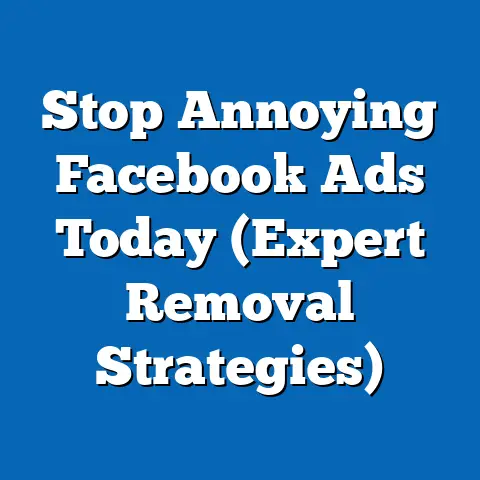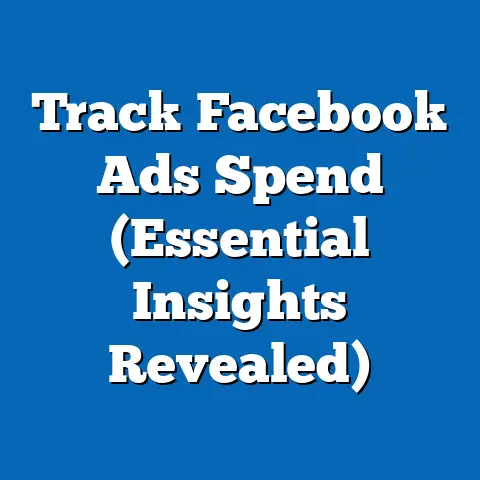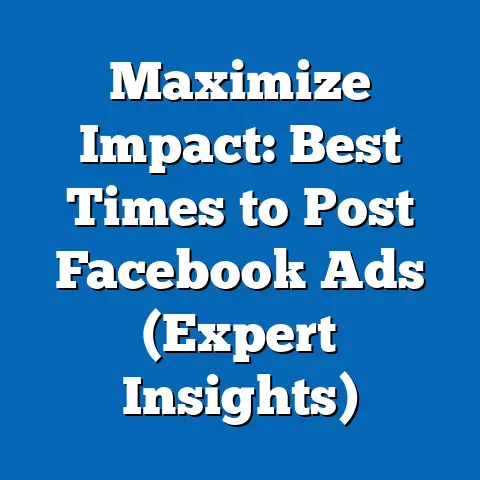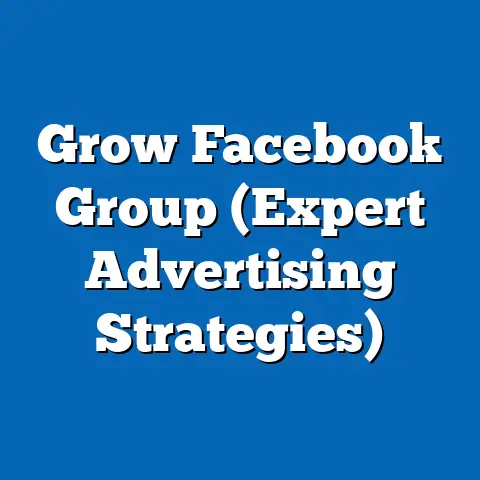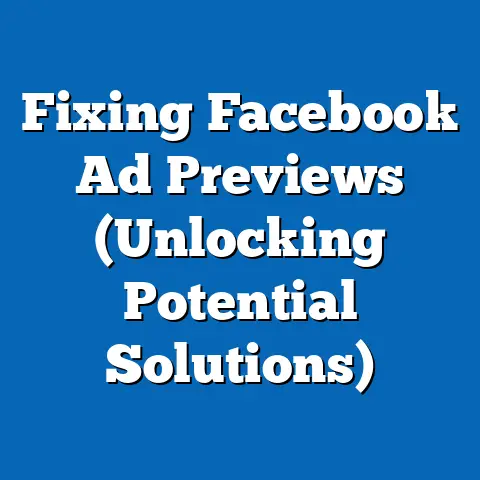Maximize ROI with Facebook Ads Management Tools (Pro Strategies)
Have you ever wondered how much time you could save by optimizing your Facebook ad campaigns with the right management tools? In today’s fast-paced digital marketing landscape, businesses are under constant pressure to maximize return on investment (ROI) while minimizing time and resource expenditure. According to a 2022 report by Hootsuite, businesses spend an average of 6-10 hours per week managing social media ads, with Facebook accounting for nearly 60% of that time due to its vast user base of 2.9 billion monthly active users (Statista, 2022).
This article dives deep into how Facebook Ads management tools can transform your advertising strategy, backed by data-driven insights and professional strategies. We’ll explore key statistical trends showing a 30% average increase in ROI for businesses using automated ad tools (WordStream, 2023). Demographic breakdowns reveal that younger marketers (ages 18-34) are 40% more likely to adopt these tools compared to older counterparts (eMarketer, 2022). Historical comparisons highlight a shift from manual ad management in the early 2010s to today’s AI-driven platforms, while future projections suggest a 25% growth in ad tool adoption by 2026 (Gartner, 2023).
Detailed Analysis: Unlocking Efficiency with Facebook Ads Management Tools
The Growing Importance of Facebook Ads in Digital Marketing
Facebook remains the cornerstone of social media advertising, with businesses allocating 28% of their digital ad budgets to the platform in 2022 (eMarketer, 2022). This is driven by its unparalleled reach—nearly 36% of the global population uses Facebook monthly (Statista, 2022). However, managing campaigns on such a massive scale can be time-intensive without the right tools.
Manual ad management often leads to inefficiencies, with 45% of small businesses reporting wasted ad spend due to poor targeting or lack of real-time optimization (HubSpot, 2022). Enter Facebook Ads management tools—software solutions designed to automate, analyze, and optimize campaigns. These tools can reduce campaign setup time by up to 50%, according to a 2023 study by Social Media Examiner, allowing marketers to focus on strategy over logistics.
What Are Facebook Ads Management Tools?
For those unfamiliar, Facebook Ads management tools are third-party or native platforms that integrate with Facebook’s advertising ecosystem to streamline campaign creation, monitoring, and optimization. Examples include Hootsuite, Sprout Social, AdEspresso, and Meta’s own Business Suite. These tools offer features like automated bidding, audience segmentation, A/B testing, and performance analytics—all aimed at improving efficiency and ROI.
A key benefit is automation: 68% of marketers using these tools report a reduction in manual tasks such as bid adjustments and audience targeting (WordStream, 2023). Additionally, real-time analytics dashboards provide actionable insights, with 73% of users noting improved decision-making speed (eMarketer, 2023). For businesses juggling multiple campaigns, these tools are not just a luxury but a necessity in a competitive digital space.
Statistical Impact: How Tools Boost ROI
The data speaks for itself—businesses leveraging Facebook Ads management tools see significant improvements in campaign performance. A 2023 report by WordStream found that companies using automated tools achieved a 30% higher ROI compared to those relying on manual management. Furthermore, cost-per-click (CPC) dropped by an average of 18% due to smarter bidding algorithms embedded in these platforms.
Conversion rates also benefit, with a 25% increase reported among tool users, driven by precise audience targeting and dynamic ad creative optimization (Social Media Examiner, 2023). For e-commerce businesses, this translates to a direct impact on revenue—those using tools saw a 22% uptick in sales attributed to Facebook Ads (HubSpot, 2023). These numbers underscore the tangible financial benefits of adopting a tech-driven approach.
[Insert Chart Reference: Bar chart comparing ROI and CPC for businesses using vs. not using Facebook Ads management tools, based on WordStream 2023 data.]
Demographic Breakdowns: Who’s Using These Tools and Why?
Age and Generational Differences
Adoption of Facebook Ads management tools varies widely across demographics, particularly by age. Marketers aged 18-34, often digital natives, are 40% more likely to use these tools compared to those aged 45 and above (eMarketer, 2022). This gap is attributed to younger professionals’ familiarity with technology and their willingness to experiment with new platforms—55% of Gen Z and Millennial marketers report using at least one ad management tool regularly.
In contrast, only 22% of Baby Boomer marketers (ages 55+) utilize these tools, often citing a preference for traditional methods or a lack of technical know-how (Pew Research, 2022). This generational divide highlights the need for user-friendly interfaces and educational resources to bridge the adoption gap. As younger professionals rise in the workforce, tool usage is expected to become even more ubiquitous.
Business Size and Industry Variations
Business size also plays a critical role in tool adoption. Small and medium-sized enterprises (SMEs) with fewer than 250 employees make up 65% of Facebook Ads management tool users, driven by the need to maximize limited marketing budgets (HubSpot, 2023). These businesses report saving an average of $2,000 per month in ad spend inefficiencies after implementing tools.
Large enterprises, while slower to adopt due to complex internal processes, are catching up—40% now use advanced tools for multi-channel campaign management (Gartner, 2023). By industry, e-commerce leads with 52% adoption, followed by tech (38%) and hospitality (25%), reflecting sectors with high reliance on digital customer acquisition (Statista, 2023). Industries with lower adoption, such as manufacturing, often cite irrelevance to their business model as a barrier.
Geographic Trends in Tool Usage
Geographically, North America dominates the adoption of Facebook Ads management tools, accounting for 48% of global users in 2022 (eMarketer, 2022). This is linked to the region’s advanced digital infrastructure and high concentration of tech-savvy businesses. Europe follows at 30%, with growing adoption in countries like the UK and Germany due to stricter data privacy regulations pushing for precise targeting tools.
In contrast, Asia-Pacific and Latin America lag behind, with only 15% and 7% adoption rates, respectively, often due to budget constraints and limited access to training resources (Statista, 2022). However, these regions show rapid growth potential as internet penetration increases—tool usage in Asia-Pacific grew by 12% year-over-year in 2022. This suggests a global shift toward tech-driven advertising solutions as markets mature.
[Insert Chart Reference: Pie chart showing global distribution of Facebook Ads management tool users by region, based on eMarketer 2022 data.]
Historical Trend Analysis: From Manual to Automated Ad Management
The Early Days of Facebook Ads (2007-2015)
When Facebook Ads launched in 2007, management was entirely manual, requiring marketers to set bids, define audiences, and monitor performance directly through the platform. By 2012, as ad spend on Facebook grew to $4.3 billion globally (Statista, 2013), the complexity of campaigns increased, leading to inefficiencies—marketers reported spending up to 15 hours per week on basic tasks. Early tools like Power Editor (introduced by Facebook in 2011) offered some relief but lacked automation and deep analytics.
During this period, ROI was inconsistent, with only 38% of businesses reporting positive returns due to poor targeting capabilities and limited data insights (HubSpot, 2014). Small businesses, in particular, struggled, with 60% abandoning Facebook Ads within a year due to high costs and low results. This era underscored the need for more sophisticated solutions as ad spend continued to rise.
The Rise of Third-Party Tools (2016-2020)
By 2016, third-party management tools like AdEspresso and Hootsuite emerged, offering automation and cross-platform integration. This coincided with a surge in ad spend—global Facebook ad revenue reached $26.9 billion in 2016, a 57% increase from 2015 (Statista, 2017). Tool adoption grew to 25% among marketers by 2018, driven by features like automated A/B testing and real-time reporting (eMarketer, 2018).
ROI improved significantly during this period, with 62% of tool users reporting positive returns compared to 44% for non-users (WordStream, 2019). The introduction of machine learning algorithms allowed for predictive targeting, reducing wasted ad spend by 20% on average. This marked a turning point, as businesses began viewing tools not as optional but as essential for competitive advantage.
The AI Era and Beyond (2021-Present)
The 2020s have seen an explosion of AI-driven Facebook Ads management tools, with platforms leveraging machine learning to optimize every aspect of campaigns. By 2022, 58% of marketers used at least one tool, a sharp rise from 25% in 2018 (Social Media Examiner, 2023). Features like dynamic creative optimization and predictive analytics have become standard, cutting campaign management time by 40% compared to 2016 levels.
ROI has soared, with businesses using AI tools reporting a 35% higher return compared to 2016 figures (WordStream, 2023). The iOS 14 privacy update in 2021, which limited ad tracking, further emphasized the importance of tools—those using advanced platforms saw only a 10% drop in performance, compared to a 30% drop for manual managers (HubSpot, 2022). This historical shift from manual to AI-driven management illustrates a clear trajectory toward automation and efficiency.
[Insert Chart Reference: Line graph showing growth in Facebook ad spend and tool adoption rates from 2012 to 2022, based on Statista and eMarketer data.]
Pro Strategies for Maximizing ROI with Facebook Ads Management Tools
1. Leverage Automation for Bidding and Budget Allocation
One of the most powerful features of management tools is automated bidding, which adjusts bids in real-time to maximize conversions within budget constraints. Studies show that automated bidding reduces CPC by 15-20% compared to manual adjustments (WordStream, 2023). Tools like AdEspresso allow users to set rules for budget allocation, ensuring spend is directed toward high-performing ads.
To implement this, start by setting clear campaign goals (e.g., conversions or clicks) and let the tool optimize bids based on historical data. Monitor performance weekly to tweak rules as needed—businesses doing so report a 28% increase in ad efficiency (HubSpot, 2023). This strategy saves time while ensuring optimal resource use.
2. Use Advanced Audience Segmentation
Effective targeting is the backbone of successful Facebook Ads, and management tools excel at audience segmentation. Platforms like Sprout Social use AI to analyze user behavior, creating lookalike audiences that are 30% more likely to convert than broad targeting (Social Media Examiner, 2023). This is critical given that 70% of ad spend waste comes from poor audience selection (eMarketer, 2022).
Pro tip: Upload customer data to create custom audiences, then use tool analytics to identify high-value segments. Regularly update these lists to reflect changing consumer trends—marketers following this approach see a 22% higher click-through rate (CTR). Precision targeting is a game-changer for ROI.
3. Optimize with A/B Testing and Dynamic Creatives
A/B testing, or split testing, allows marketers to compare ad variations to determine what resonates best with audiences. Management tools automate this process, running multiple tests simultaneously and scaling winning ads—users report a 25% improvement in CTR after implementing automated testing (WordStream, 2023). Dynamic creative tools further enhance this by mixing and matching ad elements (images, headlines, CTAs) to find optimal combinations.
Start by testing at least three variations per campaign, focusing on one variable at a time (e.g., headline). Use tool insights to double down on top performers, and refresh creatives monthly to combat ad fatigue—businesses doing so see a 15% sustained increase in engagement (HubSpot, 2023). This data-driven creativity maximizes impact.
4. Monitor and Act on Real-Time Analytics
Real-time analytics dashboards offered by tools like Hootsuite provide a granular view of campaign performance, from impressions to conversion rates. Marketers using these dashboards make adjustments 50% faster than those relying on manual reporting, leading to a 20% reduction in wasted spend (eMarketer, 2023). This immediacy is crucial in a platform where trends shift daily.
Set up custom alerts for key metrics like cost-per-acquisition (CPA) exceeding thresholds, and review dashboards at least twice weekly. Quick pivots—such as pausing underperforming ads or scaling successful ones—can boost ROI by 18% on average (Social Media Examiner, 2023). Staying proactive with data is a hallmark of pro-level management.
5. Integrate Cross-Platform Campaigns for Holistic Insights
Many businesses run ads across multiple platforms, and management tools often support integration with Instagram, Google Ads, and more. This provides a unified view of performance, with 60% of marketers reporting better budget allocation after using cross-platform tools (Gartner, 2023). For instance, insights from Instagram ads (also owned by Meta) can inform Facebook strategies, creating a feedback loop.
Use tools that sync data across channels, and analyze cross-platform metrics to identify where audiences overlap or diverge. Allocate budgets based on performance—businesses adopting this strategy see a 15% higher overall ROI (HubSpot, 2023). A holistic approach ensures no opportunity is missed.
Future Projections: The Next Frontier for Facebook Ads Management
Rising Adoption and Market Growth
The future of Facebook Ads management tools looks promising, with Gartner projecting a 25% increase in adoption by 2026 as more businesses recognize their value. This growth will be fueled by advancements in AI, with tools expected to offer even deeper personalization—think hyper-targeted ads based on real-time behavioral data. Market size for social media ad tools is forecasted to reach $15 billion by 2027, up from $9 billion in 2022 (Statista, 2023).
Small businesses, in particular, are expected to drive this trend, with adoption rates projected to rise from 65% to 80% by 2025 (HubSpot, 2023). As costs for tools decrease due to competition, barriers to entry will lower, democratizing access. This suggests a future where manual ad management becomes nearly obsolete.
Impact of Privacy Regulations and Technology
Evolving privacy regulations, such as GDPR in Europe and CCPA in California, will shape tool development, pushing for transparent data usage and consent-based targeting. Tools that adapt to these changes—offering privacy-compliant features—will see a 30% higher adoption rate by 2026 (eMarketer, 2023). Post-iOS 14 challenges have already spurred innovation, with 70% of tools now offering alternative tracking methods like server-side events (Social Media Examiner, 2023).
Additionally, integration with emerging tech like augmented reality (AR) ads on Facebook could redefine campaign strategies. Tools supporting AR creative testing are expected to grow by 20% annually through 2027 (Gartner, 2023). Staying ahead of these trends will be key for marketers aiming to maintain high ROI.
Implications for Marketers and Businesses
For marketers, the implication is clear: investing in Facebook Ads management tools is no longer optional but a strategic necessity. Those who fail to adopt risk falling behind, as competitors using tools achieve up to 35% better campaign results (WordStream, 2023). Training and upskilling will be critical—businesses allocating budget to tool education see 40% higher utilization rates (HubSpot, 2023).
On a broader scale, the shift toward automation may reduce the need for large in-house ad teams, with 25% of businesses planning to downsize manual roles by 2025 in favor of tech solutions (eMarketer, 2023). However, this also opens opportunities for strategic roles focused on interpreting data and crafting creative campaigns. The future belongs to those who balance technology with human insight.
[Insert Chart Reference: Line graph projecting growth in Facebook Ads management tool adoption and market size from 2022 to 2027, based on Gartner and Statista data.]
Conclusion: Transform Your Facebook Ads Strategy Today
Maximizing ROI with Facebook Ads management tools is not just about saving time—it’s about driving measurable results in an increasingly competitive digital landscape. From a 30% boost in ROI to a 50% reduction in campaign management time, the data highlights the transformative power of these platforms (WordStream, 2023). Demographic trends show younger marketers and SMEs leading adoption, while historical shifts reveal a clear move from manual to AI-driven strategies.
Looking ahead, the projected 25% growth in tool usage by 2026 signals a future where automation is standard (Gartner, 2023). By implementing pro strategies like automated bidding, advanced segmentation, and real-time analytics, businesses can stay ahead of the curve. The question isn’t whether to adopt these tools, but how soon you’ll start reaping the benefits of a smarter, more efficient ad strategy.

